Abstract
In thermal energy storage systems, phase change materials (PCMs) are widely used for thermal energy management. Most PCMs have low thermal conductivities, which limits the heat transfer rate within PCM and thus makes the phase-changing process very slow. However, thermal conductivities of PCMs can be altered by inserting targeted additives. We hypothesize that the size and shape of these additive inserts play a key role in thermal management efficiency. To this end, the impacts of carbon fiber (CF) inserts on the phase change behavior and consequent heat transfer efficiencies of inorganic and organic PCMs were investigated using experiments and simulations. Long, anisotropic CFs with high thermal conductivities formed continuous fast heat flux tunnels inside PCMs to enhance the heat transfer. Such CFs could extend the phase change fronts from the limited container-shaped interface to the larger surface of numerous CF inserts inside the PCM. These special CF inserts work with a new heat transfer mechanism, different from conventional small additives or long isotropic CF inserts. The thermal energy release rate increased by 2.5 times with 1 wt.% anisotropic CF inserts in inorganic PCM. However, CF inserts in liquid organic PCM hindered the natural convection and compromised the improved heat conduction. The lab-scale multiphysics simulations support these experimental observations and indicate that CF inserts have potential to enhance heat transfer in inorganic PCMs, but they are less effective in organic PCMs.





